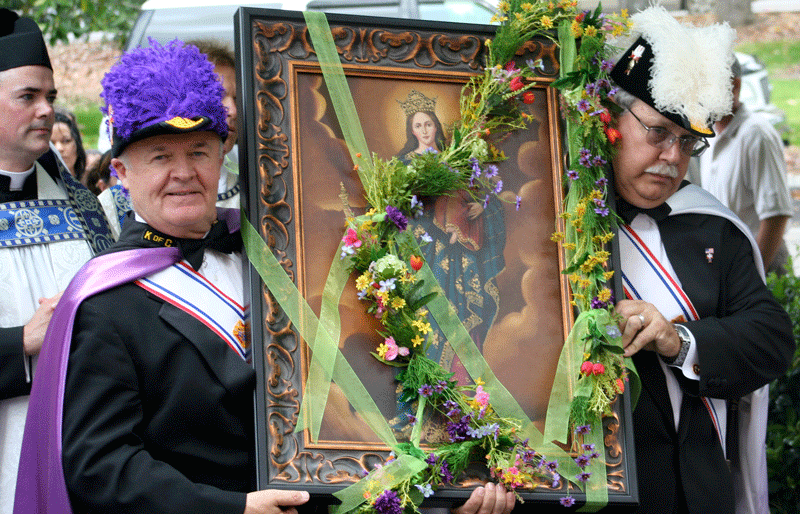
Mary is a vital part of Catholic life all year long — especially this year during the diocesan celebration of Mary running from May 14 to mid-December. Each May, however, she truly comes to the forefront of worship, thought and prayer.
This is the month of special prayers, devotions and festivals dedicated to Mary worldwide. In many churches, traditional “May processions” are held that include statues of the Blessed Mother crowned with flowers and carried by the faithful.
Traditional hymns like “Immaculate Mary,” “Sing of Mary” and “Hail Holy Queen” are a central part of May liturgies.
To help bring in the month of Mary, here are some basic questions and answers about her:
What is the true role of Mary in the Church?
Way too many Catholics have to deal with people who make the mistake of thinking we “worship” Mary. That is an easy error to make considering all of the prayers, hymns, devotions, icons and artwork devoted to the Blessed Mother, but it’s an inaccurate description of her important role in the faith. In truth, Mary is venerated, not worshipped. She is considered the prime intercessor between the faithful and Christ. The Catechism of the Catholic Church states “The Church rightly honors the Blessed Virgin with special devotion. From the most ancient times the Blessed Virgin has been honored with the title of ‘Mother of God’ to whose protection the faithful fly in all their dangers and needs. (Paragraph 971). In the same paragraph, the Catechism stresses that devotion to Mary “differs essentially from the adoration which is given to the Incarnate Word and equally to the Father and the Holy Spirit.”
Why is May dedicated to Mary?

The practice of dedicating this month to the Blessed Mother dates back to the end of the 13th century, when some historians say the Church used devotion to Mary as a way of Christianizing secular feasts that were popular at the time. The Jesuits in Rome especially adopted the tradition of public May devotion to Mary around 1700, and popes during the 19th century promoted the devotion as well.
What are some ways to honor Mary through prayer?
Two of the most common and treasured devotions to Mary are the Hail Mary and the rosary.
What is the Hail Mary and where does it come from?
The Hail Mary is the Church’s central prayer for Mary’s intercession. It is based on the Angel Gabriel’s greeting to Mary in the Gospel of Luke (Luke 1:28). The prayer’s phrase “Blessed is the fruit of thy womb, Jesus” is based on Elizabeth’s greeting to Mary later in the Gospel (Luke 1:42). The concluding petition “Holy Mary, mother of God, pray for us sinners, now and at the hour of our death” was first included in the Catechism of the Council of Trent in 1566. Prayers similar to the Hail Mary first emerged in the Church after about 1050, according to the Catholic Encyclopedia.
Why do we pray the Rosary and where does it come from?
The rosary is one of the most important prayers associated with Mary and is central to the prayer lives of many Catholics. According to the Catholic Encyclopedia, its origins can be traced to the use of prayer beads and ropes which were used to count prayers in Europe, the Middle East and Asia from the earliest days of Christianity. The earliest structure of the rosary seems to have evolved between the 12th and 15th centuries, with the five decade structure we know now emerging around the 16th century. Some Catholic traditions state that St. Dominic came up with the rosary as we know it after he had a vision of Mary, although other historians dispute this. There are four sets of mysteries prayed on the rosary, traditionally on different days of the week: the Joyful, Sorrowful, Glorious and Luminous mysteries.
Amy Lindler of Greenville owns her own company, Glorious Beads, and spends many hours making custom made rosaries, each with their own color and theme. She said the rosary became a central part of her life after she became a Catholic 13 years ago.
“The rosary is important because praying it is a daily reminder of the life of Christ and of Mary,” she said. “You never lose sight of the sacrifices that He made, the miracles He performed and the miracle of Mary as the blessed virgin.”
What are certain colors, flowers and other images associated with Mary?
The color blue: Many works of art and statues of Mary depict her wearing blue garments, and many Marian medals and rosaries also feature the color. Although we have no way of knowing what color the Blessed Mother wore most often, blue associated with Mary is said to have emerged from Byzantine tradition around the year 500 because it was the color of an empress. Other traditions associate blue with royalty, peace and nature, which fits with Mary’s associations as Queen of Heaven and Earth.
Flowers: Lilies are frequently associated with Mary as a symbol of virginity and purity. and roses symbolize her mystical participation in the Holy Trinity. Both flowers are frequently used to crown statues of Mary during traditional May processions and are laid at the feet of statues. Another flower, the iris, has been used to symbolize the “Seven Sorrows’ she experienced during her life.
Treading on the serpent: One of the most common portrayals of Mary is a statue commonly seen in churches and classrooms that features her treading on a snake. This portrayal is related to her role as the “New Eve” in the Church, who through her birth without original sin represents the defeat of evil. (Catechism of the Catholic Church, paragraph 511).
Top photo: In this file photo from 2012, Father Greg Wilson and Knights of Columbus Jim Loftis and Tom Monahon take part in a May procession in honor of Mary at St. Mary Help of Christians Church in Aiken.

